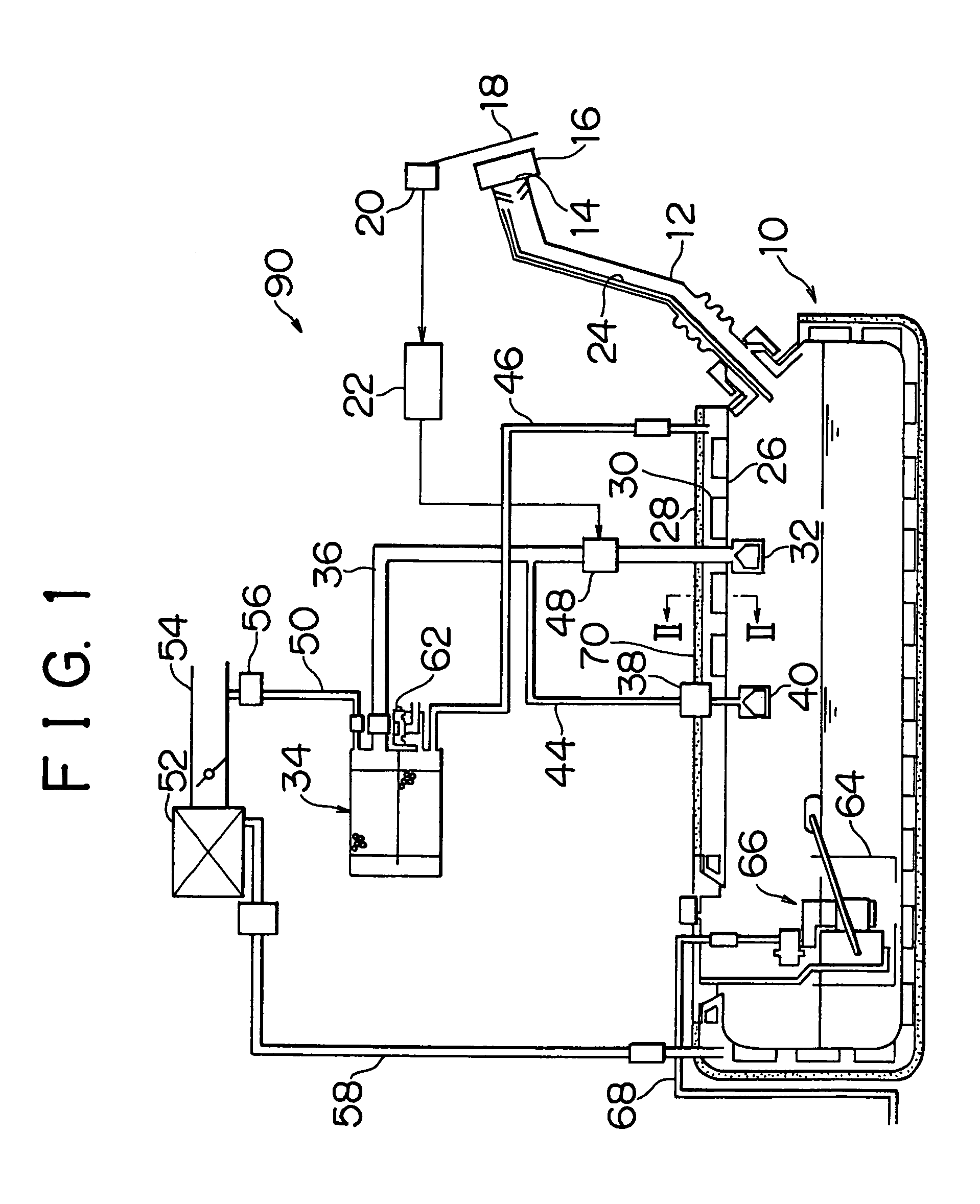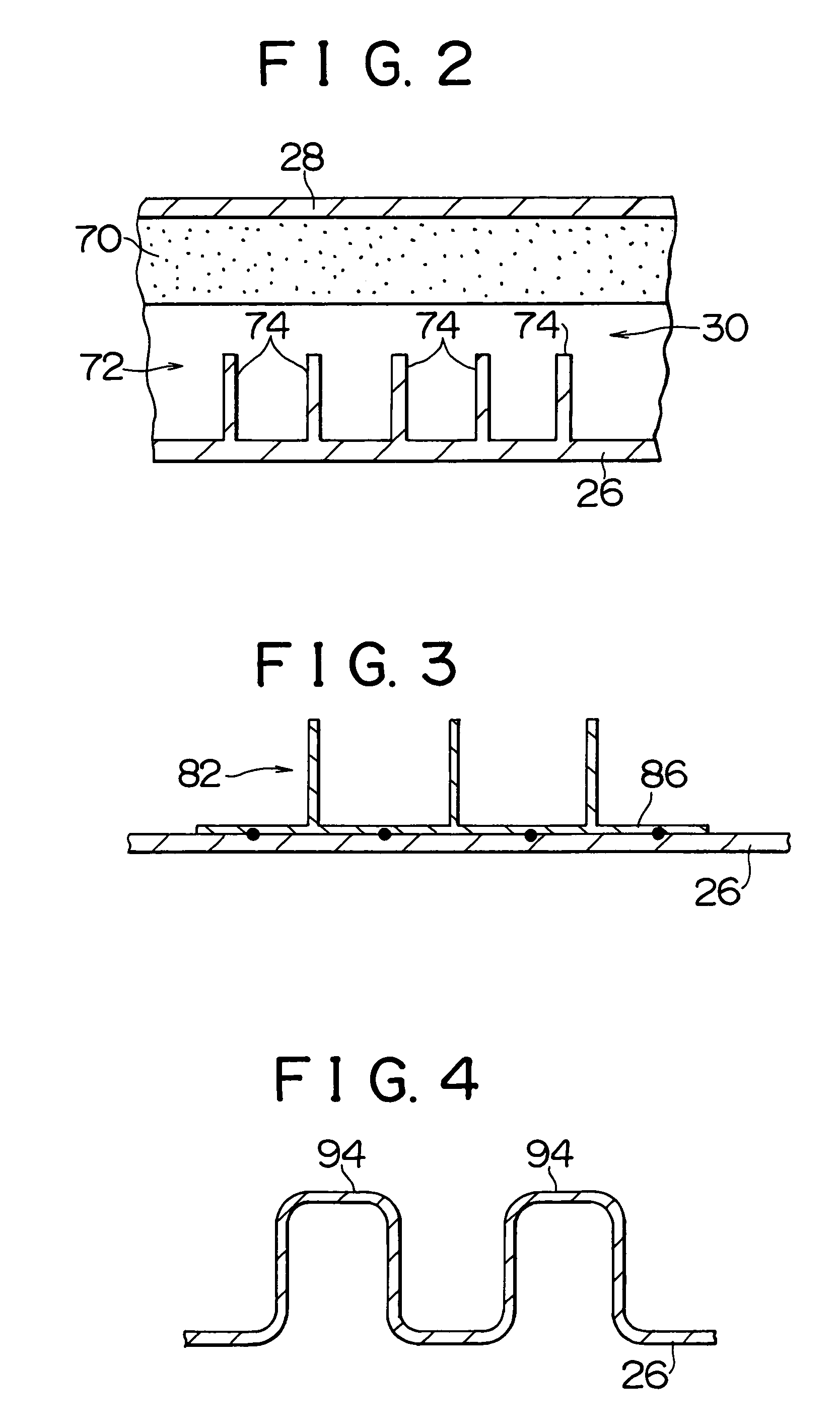Fuel tank system
a fuel tank and system technology, applied in the field of fuel tank systems, can solve the problem that the cooling effect cannot be achieved insufficiently, and achieve the effect of efficiently cooling the fuel tank
- Summary
- Abstract
- Description
- Claims
- Application Information
AI Technical Summary
Benefits of technology
Problems solved by technology
Method used
Image
Examples
first embodiment
[0038]A fuel tank system in accordance with the present invention will be described with reference to FIGS. 1 and 2.
[0039]As shown in FIG. 1, in a fuel tank system 90 of this embodiment, one end of an inlet pipe (a fuel filling pipe) 12 penetrates a lateral wall portion of a fuel tank body 10. The end of the inlet pipe 12 is inserted into the fuel tank body 10. The other end of the inlet pipe 12 reaches a feed oil port 14 provided in a vehicular lateral wall portion.
[0040]A feed oil cap 16 is mounted to the feed oil port 14. In feeding oil, a feed oil gun (not shown) can be inserted through the feed oil port 14 by opening a fuel lid 18 and removing the feed oil cap 16. In feeding oil, if a fuel level in the inlet pipe 12 rises and a sensor attached to the feed oil gun detects a filled-up state, feed oil operation by the feed oil gun is automatically stopped. The fuel lid 18 is equipped with an open-close detection switch 20 for detecting an open or closed state of the fuel lid 18. T...
second embodiment
[0058]In the second embodiment shown in FIG. 3, a heat radiation member 82 formed separately from the inner tank shell 26 is mounted to the outer surface of the inner tank shell 26. The heat radiation member 82 is composed of a stationary plate 86 fixed to the inner tank shell 26 and heat radiation fins 84 erected from the stationary plate 86.
[0059]The stationary plate 86 is welded at a predetermined portion and fixed to the inner tank shell 26, whereby the heat radiation member 82 is mounted to the inner tank shell 26.
[0060]Thus, also in the second embodiment, as in the first embodiment, heat of fuel in the fuel tank body 10 is discharged into the inter-tank-shell space 30 through the heat radiation member 82. Thus, fuel in the fuel tank body 10 is prevented from rising in temperature, and generation of vapor is inhibited.
[0061]As long as the heat radiation member 82 can be mounted to the inner tank shell 26, means other than the aforementioned welding can also be employed. For exa...
third embodiment
[0062]In the third embodiment shown in FIG. 4, the periphery of the inner tank shell 26 is generally undulate, so that a plurality of beads 94 are provided in the inner tank shell 26. In this manner, an enlarged surface area of the inner tank shell 26 constitutes heat radiation means.
[0063]Also in the third embodiment, as in the first and second embodiments, heat of fuel in the fuel tank body 10 is discharged into the inter-tank-shell space 30 through the beads 94. Thus, fuel in the fuel tank body 10 is prevented from rising in temperature, and generation of vapor is inhibited. Besides, as in the first embodiment, since heat radiation means (the beads 94) is integrated with the inner tank shell 26, the number of parts does not increase in comparison with the case where heat radiation means is provided separately.
[0064]In this manner, any of the aforementioned embodiments makes it possible to reduce a generation amount of vapor not only by preventing a rise in temperature resulting f...
PUM
 Login to View More
Login to View More Abstract
Description
Claims
Application Information
 Login to View More
Login to View More - R&D
- Intellectual Property
- Life Sciences
- Materials
- Tech Scout
- Unparalleled Data Quality
- Higher Quality Content
- 60% Fewer Hallucinations
Browse by: Latest US Patents, China's latest patents, Technical Efficacy Thesaurus, Application Domain, Technology Topic, Popular Technical Reports.
© 2025 PatSnap. All rights reserved.Legal|Privacy policy|Modern Slavery Act Transparency Statement|Sitemap|About US| Contact US: help@patsnap.com



